
One of the lesser known and discussed benefits of Correct Toes toe spacers is their ability to boost foot and toe circulation. Many Correct Toes users have reported this great benefit, but until now we haven’t actually been able to see this effect or quantify it. Thanks to a Correct Toes user (Sergio, from Spain) and the wonders of infrared (IR) imaging, we can now see the magnitude of Correct Toes’ effect on foot and toe blood flow. Sergio originally sent his images and feedback to Correct Toes inventor Dr. Ray McClanahan and the Northwest Foot & Ankle team, but I wanted to share these images with you here because they are a powerful visual demonstration of what Correct Toes can do for foot health.
SHOP CORRECT TOES
Before we dive into interpreting the various infrared images captured by Sergio, let's discuss why healthy foot and toe circulation is such an important thing.
Why Does Foot & Toe Circulation Matter?

Foot and toe blood flow matters because it’s often an indication of the health of the general circulatory system. Compromised blood flow to the extremities can be a sign of a significant health problem that requires monitoring and appropriate care. Conditions such as diabetes, peripheral arterial disease, and Raynaud’s can all affect circulation in the feet and toes. Left unattended, some of these conditions can progress and cause larger health problems that require more drastic interventions in order to bring under control.
In a more general sense, though, foot and toe circulation matters because it affects the health of foot and toe tissues. Fresh, oxygenated blood needs to reach all of the foot’s tissues via the small arteries in the feet and toes, and deoxygenated blood carrying harmful metabolic byproducts needs to get flushed out of the foot. When these important physiological processes are impeded (often by conventional footwear, which forces the big toe out of alignment), the tissues of the plantar fascia can be disproportionately affected, leading to plantar fascia pain and problems.
Also significant is the role that circulation plays in thermoregulation: Where there is sufficient blood flow, there is warmth. Cold feet and toes are a major problem for a large number of people. For those interested in learning more about circulation and feet, this article discusses the topic in greater detail, and this video discusses tips to improve foot circulation.
Various Infrared Images & What They Show
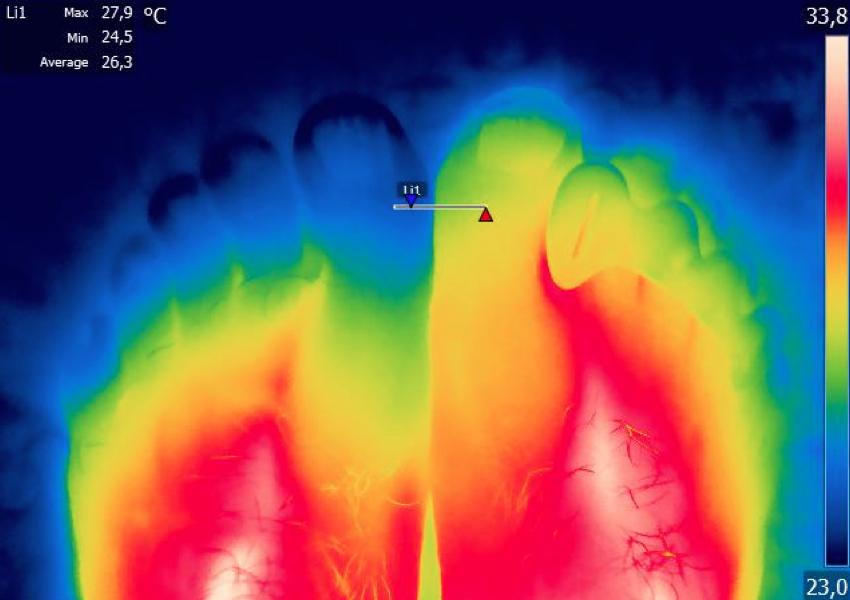
Sergio, a certified building energy auditor in Madrid, snapped numerous infrared images that depict the very significant effect that Correct Toes has on foot and toe blood flow. Here is a short note from Sergio describing the incredible image that appears above as well as his investigative process:
This picture was taken two days after I bought my Correct Toes. I felt so good, resting better since the first day. On the second day, I decided to see what was happening in my feet wearing Correct Toes, so I put on Correct Toes on my right foot and not on my left foot. I did normal life, and after 1 hour of wearing [the toe spacers] I took my IR camera to see what nobody can see: the heat. And then I show, clearly, that my right foot, the one with Correct Toes, was warmer than my left foot. Blood can go to the end of my toes to warm them.
The image that appears above is an amazing visual representation of the effect of Correct Toes on foot and toe blood flow. The darker areas represent regions of reduced blood flow, while the lighter/brighter areas are regions of greater blood flow.
Sergio states that IR images provide a much more detailed picture of what’s actually happening in the real world, whether it’s inside a building or inside the human body. He notes:
Visual images are what people see and think that everything is normal, under control, but when I turn on my IR camera they see that not everything is right. People can feel their cold toes, but when they see the IR picture, they make the decision to do something. It is like energy saving—many people don't act until I show them how energy flows out of the building.
Here is another image from Sergio that demonstrates the role of Correct Toes in enhancing foot and toe blood flow:
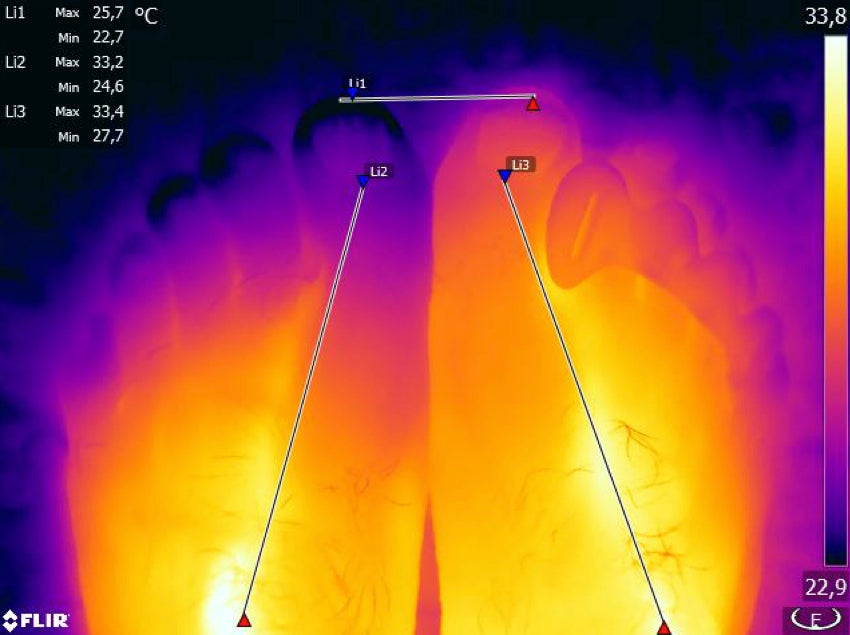
This image shows temperature variations within the foot and between the feet. Notice that the temperature in the midfoot area is approximately the same (33.2 to 33.4 degrees Celsius, or about 94 degrees Fahrenheit) in both feet and that both big toes are relatively cooler than the midfoot. Now notice the rather large temperature differences between the right and left big toes and feet: The right big toe (the Correct Toes side) is a full 3 degrees Celsius (~5 degrees Fahrenheit) warmer than the big toe on the left! What’s also important to note is that the difference in temperature between the midfoot and the big toe is 3 degrees Celsius less on the right (the Correct Toes side) than on the left. In other words, the right big toe keeps more heat due to the greater blood flow it’s receiving.
SHOP CORRECT TOES
Here is an array of powerful IR images showing the extraordinary impact of Correct Toes on foot and toe circulation:
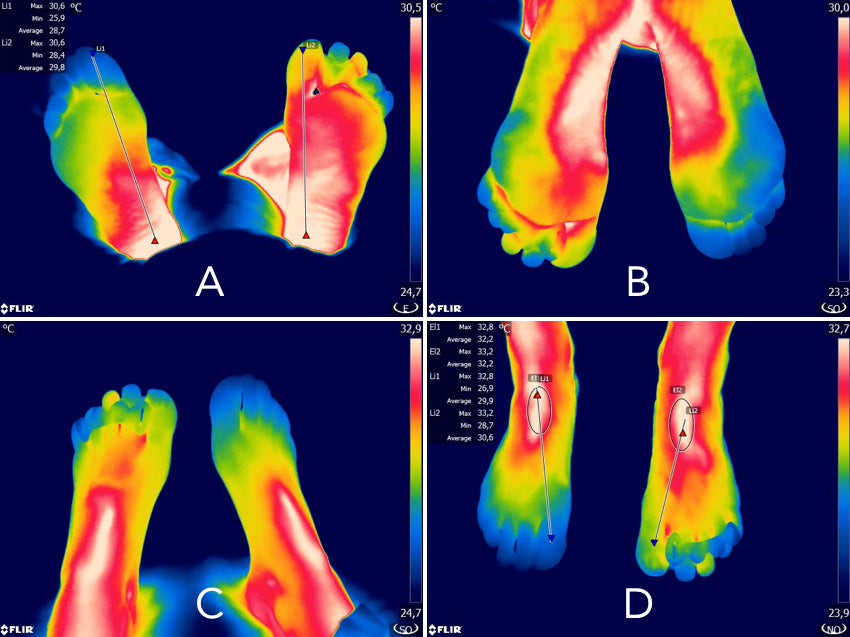
These images, like the previous ones, show the heat signature (i.e., areas of high and low blood flow) on the Correct Toes and non-Correct Toes feet, but from various angles. A Correct Toes toe spacer appears on the left foot in all the images. Images A and B show the heat signature on the underside of the foot, while Image C shows the feet at a slightly inverted angle. Image D is another shot of the top of the feet and does a great job depicting the significant differences between the Correct Toes and non-Correct Toes feet.
Images A and B are particularly powerful because they depict the drastic difference in blood flow to the plantar fascia that occurs between a foot with Correct Toes on and a foot without Correct Toes on. Indeed, there appears to be significantly more heat and blood flow in these tissues on the Correct Toes side, which makes intuitive sense when you understand the role of a perfectly aligned big toe on blood flow through the posterior tibial artery (the vessel that delivers fresh blood to the plantar fascia)—more on this below.
How Does Correct Toes Boost Foot Circulation?

So, the visual evidence of Correct Toes’ effect on foot and toe circulation is in. But why, exactly, is Correct Toes so helpful in boosting blood flow to these tissues? I believe there are two main reasons that help explain why this is so:
-
Decreased Pressure on the Metatarsal & Digital Arteries: In every foot, neurovascular bundles (which contain a nerve, a metatarsal artery, and a vein) travel through the narrow space between the metatarsophalangeal (MTP) joints in the forefoot. Once the metatarsal arteries reach the level of the MTP joint, they branch and send separate arteries (known as digital arteries) to the toes. That branching requires space. Conventional footwear (with its tapering toe boxes) squeezes this already tight space, which compromises blood flow to and from the toes. The lack of blood flow is usually not significant enough to cause a problem such as gangrene, but it does still have an effect on the health of the toe tissues. To use a rough analogy, what happens to these blood vessels is akin to a garden hose that gets slightly kinked. Correct Toes helps open up that space between the toes so that more blood can actually reach the toe tissues.
-
Decreased Pressure on the Posterior Tibial Artery & Vein: The posterior tibial artery and vein are key players in foot circulation. The posterior tibial artery carries blood to the foot’s plantar surface and is accompanied by the posterior tibial vein as it courses through the back of the lower leg and into the foot. In folks who wear conventional footwear with tapering toe boxes, the muscle (abductor hallucis) responsible for abducting the big toe (i.e., moving the big toe away from the rest of the foot) becomes stretched/elongated and pulls on a foot structure called the flexor retinaculum. This, in turn, restricts blood flow through the posterior tibial artery and vein and impedes circulation to and from the foot's plantar fascia. Correct Toes helps realign the big toe, which allows the abductor hallucis muscle to return to its normal length, tension, and orientation. This reduces the pull on the flexor retinaculum, eliminates constriction forces on the posterior tibial artery and vein, and allows more blood to come and go from the foot.
Correct Toes: A Natural Way to Enhance Circulation

Many Correct Toes users experience a significant reduction in foot discomfort shortly after adopting the device (depending on the particular problem being addressed), though significant progress toward correcting longstanding foot and toe deformities often takes time. This is expected, given that the problems themselves (e.g., bunions, hammertoes, neuromas, etc.) usually took many years to form. Though natural foot rehabilitation can be a process that requires equal amounts of dedication and patience, the images displayed in this article show that beneficial changes throughout the foot can happen right away, just as a function of wearing the Correct Toes device. Opening up the channels through which the blood vessels pass can yield profound foot health benefits, and Correct Toes can play a major role in helping achieve this.
SHOP CORRECT TOES

WANT TO IMPROVE YOUR FOOT HEALTH?
Let the team at Natural Footgear help you! Subscribe to our newsletter for the latest offers and helpful info, and sign up for our FREE email courses on various topics and foot health conditions.
Sign Up →
Want to Improve Your Foot Health?
We are here to help you every step of the way. Get our newsletter for the latest offers and helpful info, and sign up for our FREE email courses on various topics and conditions, including bunions, hammertoes, neuromas, plantar fasciosis, shin splints, ingrown toenails, and more.
Sign Up →
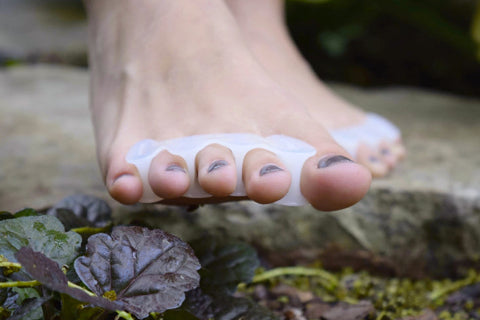 Correct Toes, a toe spacing device made of flexible and durable medical grade silicone, is a small but mighty ally when it comes to achieving and restoring optimal foot health. It's a natural alternative to the most commonly prescribed foot care products—such as arch orthotics and motion control footwear—as well as surgical procedures, and it accomplishes major foot health feats for a fraction of the cost of these more well-known...
Read more
Correct Toes, a toe spacing device made of flexible and durable medical grade silicone, is a small but mighty ally when it comes to achieving and restoring optimal foot health. It's a natural alternative to the most commonly prescribed foot care products—such as arch orthotics and motion control footwear—as well as surgical procedures, and it accomplishes major foot health feats for a fraction of the cost of these more well-known...
Read more









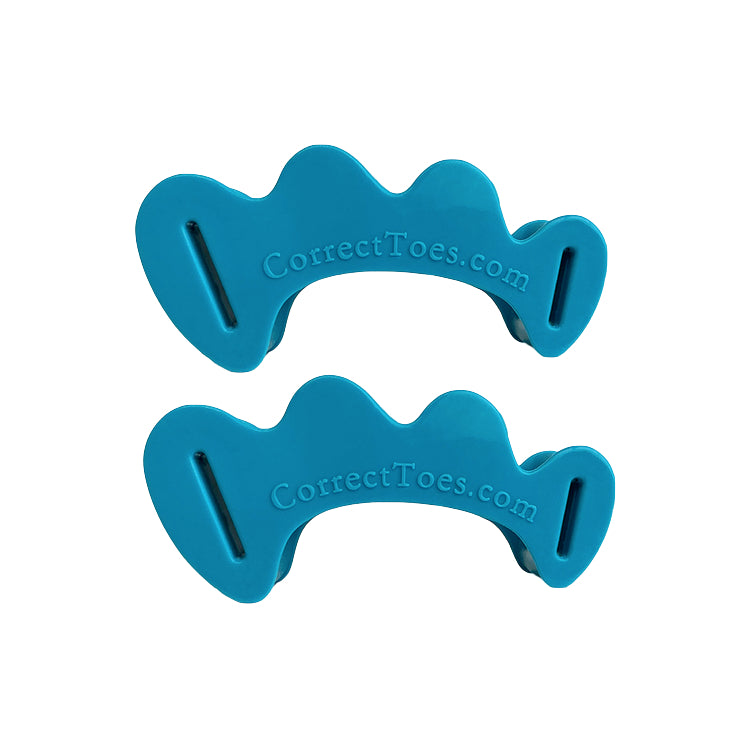
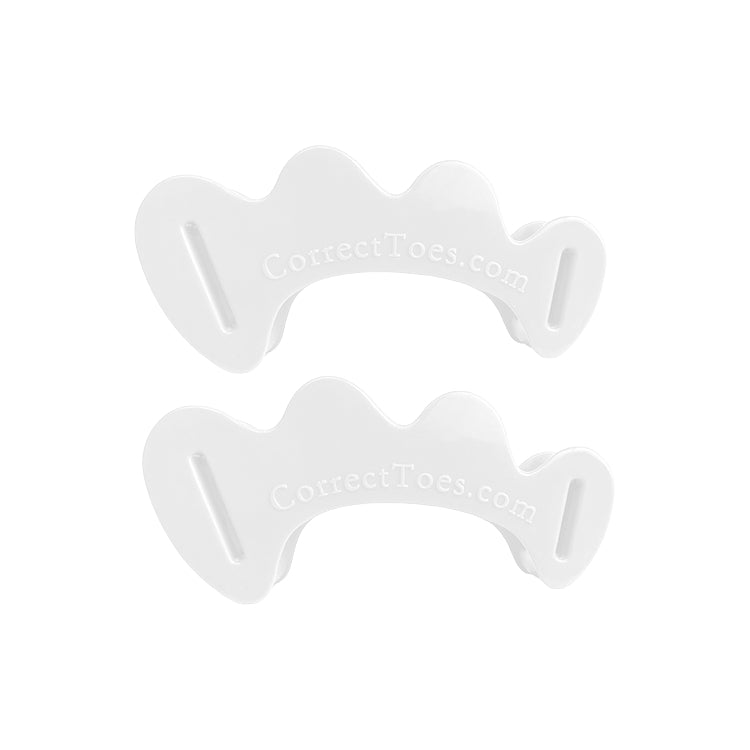
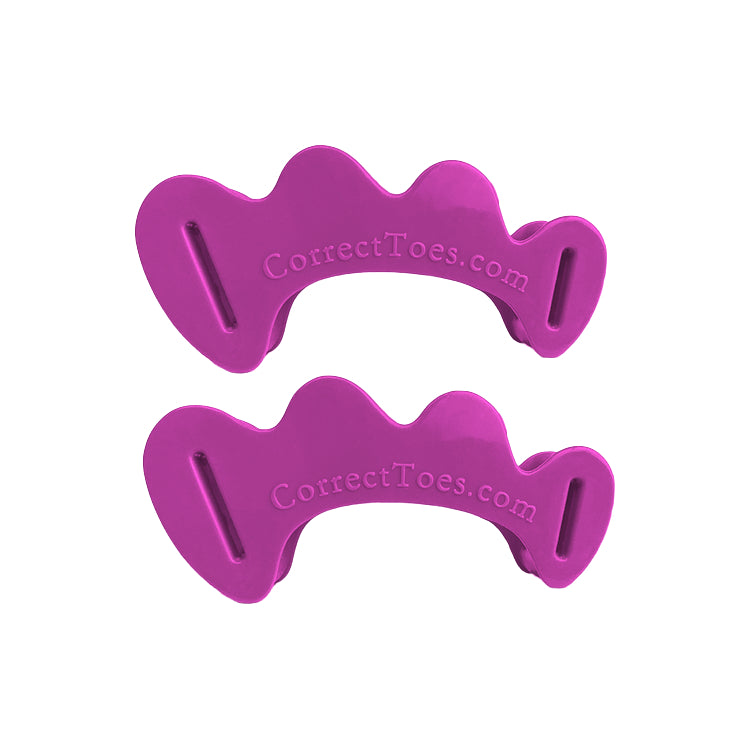
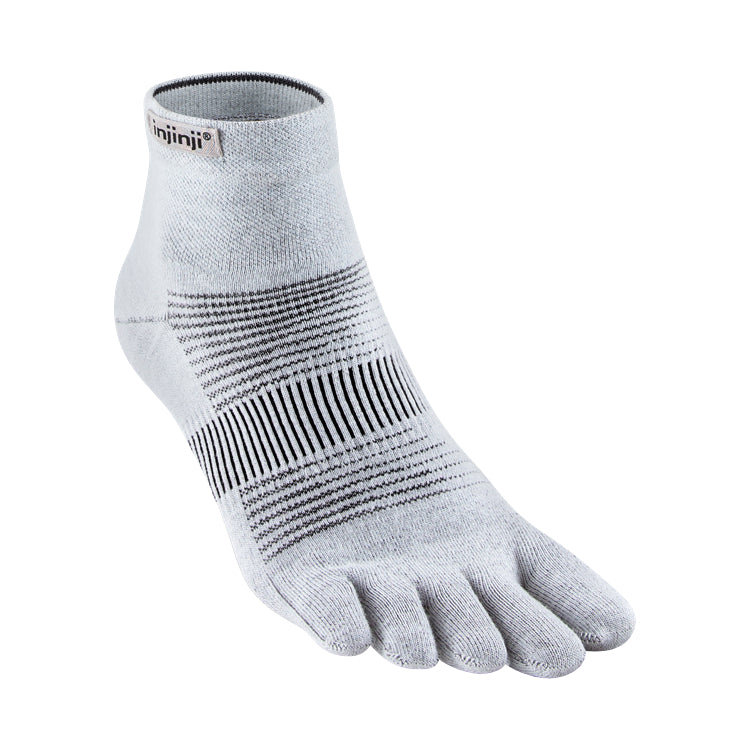
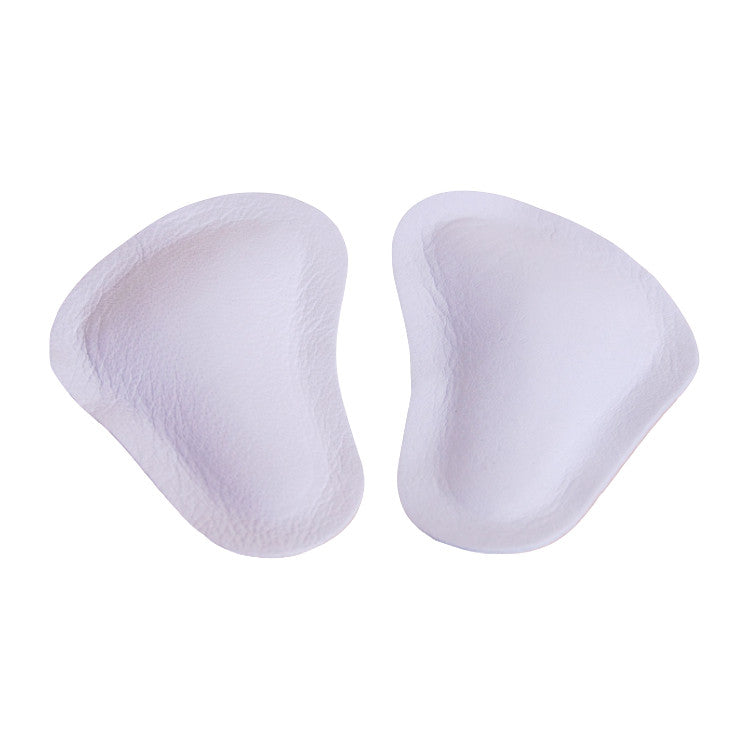
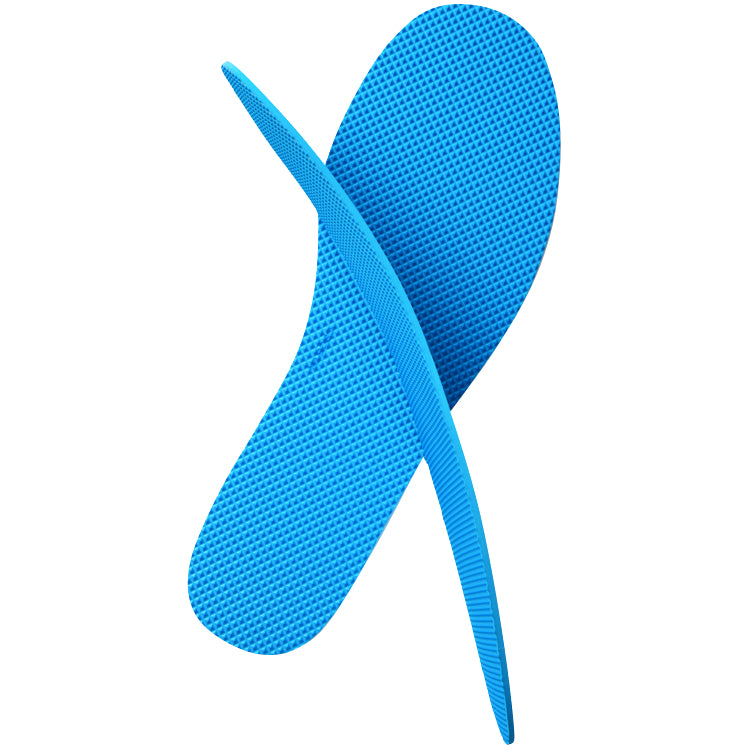
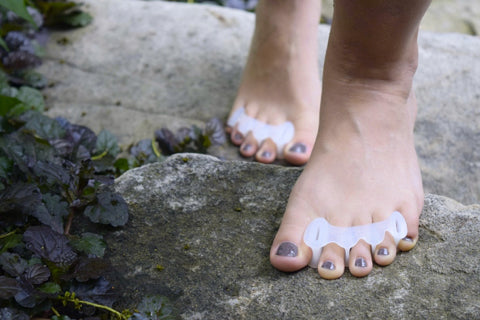
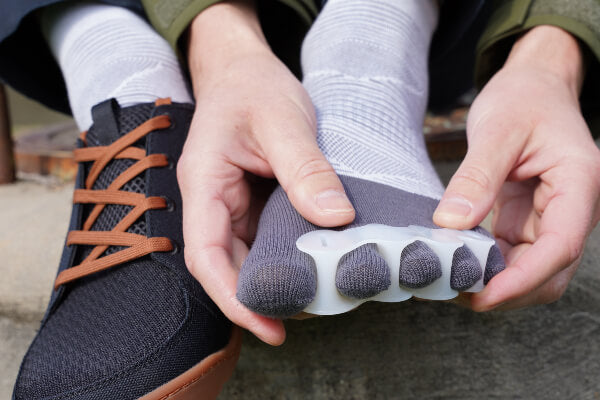
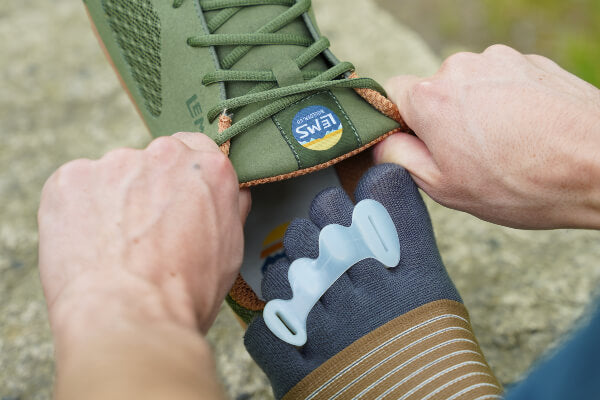
I hope that you will consider carrying some shoes that incorporate the features you have identified that are necessary for foot health in a shoe that I can wear at work in my office. Or perhaps you have some recommendations? Thanks!
Greetings, Valerie,
Thank you for your post. We are quite in tune with what the footgear market has to offer, and we have yet to encounter a truly foot-health-positive option which matches the description you provide and are seeking. Rest assured you are not alone, and it is by voicing your requests to the manufacturers that change will occur.
We advocate for you and your happiest, healthiest feet; thank you for inviting us along on your journey!
All best,
Sarah K. Schuetz
Are these meant to be worn all day? Do you wear them with shoes or just in the evenings at home?
Thank you for your questions, Cindy! Most people find that they can, ultimately, wear Correct Toes toe spacers for most (or all) of the day, though it usually takes some time to work up to this level of wear-time. We typically recommend starting in with about 30 minutes of wear-time per day for the first few days of use, and then gradually building from there (usually in 30-minute per day increments) over the following weeks. Correct Toes has its greatest corrective effect when it’s used inside appropriately wide toe box footwear during weight-bearing activity, though you can certainly use the spacers on your bare feet (or over a pair of toe socks) while lounging at home during the evenings.
For more info about Correct Toes and how to get the most out of the device, we encourage you to sign-up for our free 12-part e-course here:
www.naturalfootgear.com/pages/do-you-want-to-learn-more-about-correct-toes-toe-spacers
I hope this info is helpful, Cindy!
Kind regards,
Robyn Hughes, ND
Are you aware of any athletic cleats that a college quarterback could use to transition to natural footwear during play? My son has a terrible issue with bunions, and I feel like it is hampering his performance. I sent him a link to your website, so hopefully he will find out the steps he needs to take to improve his feet. Thank you for improving my life!!! Happiest feet ever!
Hi, Nancy. Thank you for your question. And thank you for your kind words! Much appreciated. We’re sorry to hear that your son is dealing with bunions that may be impacting his athletic performance. It’s certainly true that conventional football cleats, as well as other sport-specific footwear, can impact foot health in a negative way, given the overall tight fit, tapering toe boxes, and rigid, inflexible soles that are characteristic of this kind of shoe. It’s great that you’re seeking alternatives here, though there is still a relative dearth of options in this category for the foot-health-inclined. Companies such as Vivobarefoot may have some models that could work, and the Altra Lone Peak and Xero TerraFlex II are other possible options. There is also a company called Code Footwear that makes custom cleats that are engineered for unique sets of feet.
With the exception of the custom option mentioned above, the other shoes noted may work best during training instead of competition. It’s difficult to completely dispense with conventional sport-specific footwear for certain sports or activities, and so the next-best thing here (beyond having foot-healthy high-performance footwear that can be worn on game-day) may be to have the athlete spend as much time as possible outside of competition in foot-healthy footwear, toe spacers, toe socks, met pads, and proprioceptive insoles to help counteract the deleterious effects of conventional cleats on foot form and function. Athletes, of course, can benefit significantly from performing key exercises and using foot-building tools such as those from BlackBoard and Human Locomotion to rehabilitate the feet and improve foot resilience.
We hope this info helps your son, Nancy! If you have any follow-up questions for us, please don’t hesitate to add another comment here.
Yours in Foot Health,
Drs. Marty & Robyn Hughes